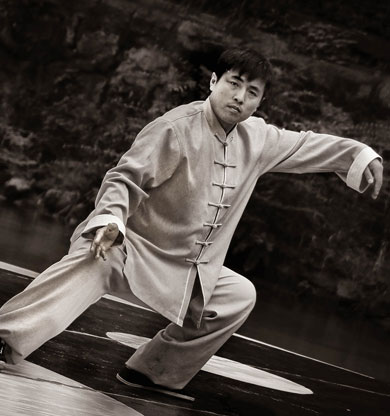
Taï-chi and Tao dance
The first principle of Isness dance is inspired by Tai Chi and lays the foundation for a dance based on energy.
Trained in Tai Chi by Philippe Laurent in Paris, Fabienne Courmont, after years of research, integrated certain practices and philosophy of Tai Chi in her method: slowness, centering in Hara, circulation of energy (Chi) in movement, Yin-Yang balance, non-duality and interiority.
NO-Theatre No and Shinto
Following her meeting with Yoshi Oïda her No- Theater and Shinto’s teacher she introduced the notion of the life’s cicle in her dance and of transcendence which involves the search for a refined gesture going to the essential. This research inspired her on the link between movement and sacred geometry.
The Shinto’s spirit is also present in Isness dance through the practice of Butô of nature and No-theatre.
Shintoism or Shinto literally “the Gods way” or “the Divine way” is the oldest spiritual voice of Japan. It comes from the dawn of time. In Shintoism, a mixture of animism and shamanism, nature is considered sacred. every element of nature can be considered a divinity or kami. The resulting deep respect defines man's place in the universe: to be an element that consciously participates in the harmony of the great whole.
The practice in Isness dance, of the Shinto exercises in the morning, symbolic and energetic gestures which are a treasure that connects us to the earth, to all creation and universe.

Original Butô and Butô of Light
Butô was founded in the sixties by Tatsumi Hijikata, who was joined by Kazuo Ohno. Born on the ruins of Hiroshima, this "dance of darkness" revolutionizes the codes of dance and forces the dancer to strip the ego. Since then it has evolved in different currents.
Butô is a form of meditation in movement. Kazuo Ohno speaks of Butô as the “dance of the soul”. Tanaka Min defines his dance as a “dance-state” or “dance-metamorphosis”. There is no style, but a state of mind where the body freed from any defined form,it can let go out what is present within ,without a priori or judgment.
Fabienne Courmont, trained in Butô in 1984 in Japan by Tanaka Min and initiated by Kazuo Ohno, has developed her own movement from her inner transformation and her research on the integral yoga of Sri Aurobindo. She calls it the Butô of light.
Unlike the Butô of darkness, where shadow and light come together without a priori or judgment, here the light illuminates the darkness to transmute it to the heart of the cells in order to raise their vibration to the frequency of love, that of the Being.
Indian sacred dance and mudras
From Swarna Mukhi who taught her in Madras the basics of Bharata Natyam, a sacred Indian dance, she integrated into Isness dance, the mudras or hands’ gestures and the offering dimension to the Divine through dance.
In the sacred dimension of dance where the dancer embodies the Divinity on earth, her gestures or mudras are powerful codes of a sacred alphabet.
The shamanic trance and the dervish dance
In many traditions trance, meditation, mantra recitation, or other practices are used to create a "modified state" of consciousness in order to gain access to certain areas of the brain, not accessible through the ordinary waking , with an higher dimension of consciousness.
The shamanic trance and the dervish dance are Isness dance’s tools which allow this opening in order to release the conscious and unconscious blockages to the freedom to be and thus to find the full potential of who we really are.

